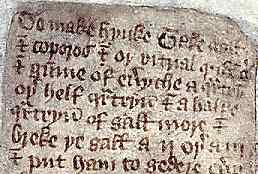Script Type : minuscule
Script Family : Gothic bastarda
Date : 15th century
Location : England
Function : Document hand or charter hand





























Distinctive letters : This interesting oddment comes from the English chancery and is a recipe for iron gall ink, so this is one for the modern scribes out there. The script is a fairly standard 15th century chancery hand of the bastarda type, as was used in legal documents such as charters, although this example appears to have been rather more hastily written. It is in English.
Among the diagnostic letters, a has the closed double loop, and g is also tightly looped and closed. The letter e is mostly what we regard as standard, except that occasionally it does the trick of rolling over backwards. Both the tall and short forms of s are present, with the short form as an open curly shape. There are also two forms of r, one of standard Gothic type and the other a simplified. open form wich extends below the baseline, typical of the English chancery style.
The letters found in English but not in Latin. w and k, are extravagantly formed with many loops. I think the scribes liked to celebrate these. The text also contains the thorn character for th and the yogh for consonantal y. The thorn character resembles a y without the backward curving curly descender. The yogh looks like a long z with a curly desender.
In general ascenders tend to form angular loops . The tendency for letters to be angular causes the usual problems in distinguishing the letters made from minims; i, m, n, u, and v. In relation to this, i is not dotted except when two or three appear together, as in Roman numerals.
There are no examples of j (unless you count the elongated i at the end of numerals), x or z in this example.
Pass the cursor slowly down the rows of text shown for a quick transcript. To examine the whole document, and perhaps cook up your own batch of medieval ink, proceed to the paleography exercise.
Paleography
exercises using Flash![]()
These require at least the Flash 5 plugin
If you are looking at this page without frames, there is more information about medieval writing to be found by going to the home page (framed) or the site map (no frames).